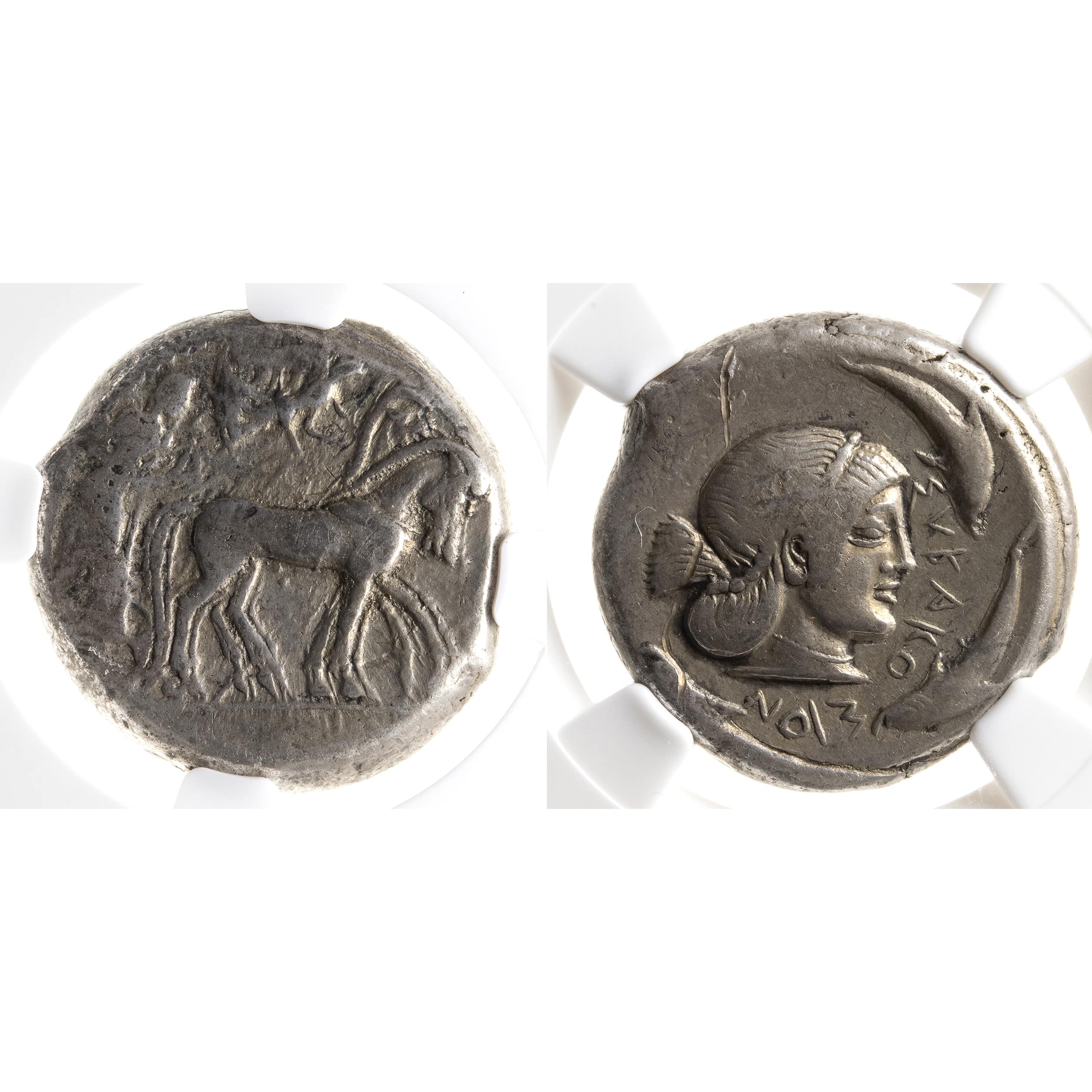Sicily, Syracuse AR Tetradrachm. Second Democracy. Circa 415-405 BC. Charioteer, holding kentron in right hand and reins in both, driving fast quadriga left; Nike flying above right, crowning charioteer with open wreath; grain ear in exergue / Diademed head of Arethusa right, wearing earring and necklace, hair in ampyx and sphendone; ΣYPAKOΣION and four dolphins around. Tudeer 63 (V22/R41); SNG ANS 281; Rizzo pl. XLVII, 10 (same dies); BMC 221 (same dies); Boston MFA 414 = Warren 382 (same dies); Gulbenkian 285 (same dies); Jameson 108 (same dies). 17.43g, 24mm, 11h. Good Extremely Fine. Very Rare. From the David Freedman Collection; Ex Roma Numismatics II, 2 October 2011, lot 108; Ex Lanz 138, November 2007, lot 129. Sicily in the mid-5th Century BC was riven by continual warfare between cities vying for pre-eminence and power over their neighbours, and such warfare required vast amounts of money to finance, money which the cities of Sicily had in abundance thanks to their favourable position on the Mediterranean trade routes. This constant state of war was contrasted by a climate of state-patronised cultural experimentation and development. Great artists, sculptors and die cutters were hired to imbue their employers' cities with elegance and grandeur; the need for ready coin to pay mercenaries naturally leant itself to the die cutter's advantage. The tetradrachms provided the ideal medium on which to explore, refine and hone their art, and while the first masters such as the 'Maestro della foglia', and the unknown master who signed his work 'A' remained anonymous on their coinage, their students proudly signed their works with their signatures, and thus are passed on to us the names of Exakestidas, Kimon, Euainetos and others. Yet while the signed dies are often among the most coveted by collectors, many of the finest dies were left unsigned – as was the case with the present piece, which though lacking a signature is nonetheless an excellent example of the very best numismatic art of the period.
Sicily, Syracuse AR Tetradrachm. Second Democracy. Circa 415-405 BC. Charioteer, holding kentron in right hand and reins in both, driving fast quadriga left; Nike flying above right, crowning charioteer with open wreath; grain ear in exergue / Diademed head of Arethusa right, wearing earring and necklace, hair in ampyx and sphendone; ΣYPAKOΣION and four dolphins around. Tudeer 63 (V22/R41); SNG ANS 281; Rizzo pl. XLVII, 10 (same dies); BMC 221 (same dies); Boston MFA 414 = Warren 382 (same dies); Gulbenkian 285 (same dies); Jameson 108 (same dies). 17.43g, 24mm, 11h. Good Extremely Fine. Very Rare. From the David Freedman Collection; Ex Roma Numismatics II, 2 October 2011, lot 108; Ex Lanz 138, November 2007, lot 129. Sicily in the mid-5th Century BC was riven by continual warfare between cities vying for pre-eminence and power over their neighbours, and such warfare required vast amounts of money to finance, money which the cities of Sicily had in abundance thanks to their favourable position on the Mediterranean trade routes. This constant state of war was contrasted by a climate of state-patronised cultural experimentation and development. Great artists, sculptors and die cutters were hired to imbue their employers' cities with elegance and grandeur; the need for ready coin to pay mercenaries naturally leant itself to the die cutter's advantage. The tetradrachms provided the ideal medium on which to explore, refine and hone their art, and while the first masters such as the 'Maestro della foglia', and the unknown master who signed his work 'A' remained anonymous on their coinage, their students proudly signed their works with their signatures, and thus are passed on to us the names of Exakestidas, Kimon, Euainetos and others. Yet while the signed dies are often among the most coveted by collectors, many of the finest dies were left unsigned – as was the case with the present piece, which though lacking a signature is nonetheless an excellent example of the very best numismatic art of the period.
/900/1217900.jpg)














Testen Sie LotSearch und seine Premium-Features 7 Tage - ohne Kosten!
Lassen Sie sich automatisch über neue Objekte in kommenden Auktionen benachrichtigen.
Suchauftrag anlegen